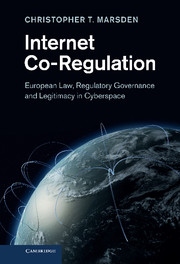Book contents
- Frontmatter
- Contents
- Acknowledgements
- Abbreviations
- Table of legislation
- 1 States, firms and legitimacy of regulation: insoluble issues?
- 2 Internet co-regulation and constitutionalism
- 3 Self-organization and social networks
- 4 An empire entire of itself? Standards, domain names and government
- 5 Content regulation and the Internet
- 6 Private ISP censorship
- 7 Analyzing case studies
- 8 Internet co-regulation as part of the broader regulatory debate
- Bibliography
- Index
7 - Analyzing case studies
Published online by Cambridge University Press: 07 September 2011
- Frontmatter
- Contents
- Acknowledgements
- Abbreviations
- Table of legislation
- 1 States, firms and legitimacy of regulation: insoluble issues?
- 2 Internet co-regulation and constitutionalism
- 3 Self-organization and social networks
- 4 An empire entire of itself? Standards, domain names and government
- 5 Content regulation and the Internet
- 6 Private ISP censorship
- 7 Analyzing case studies
- 8 Internet co-regulation as part of the broader regulatory debate
- Bibliography
- Index
Summary
Analysis across case studies
In this chapter, I first summarize and compare the case studies in the earlier chapters across SROs, discovering the factors which led to success or failure, sustainability or ossification. I explore path dependence, then funding and resources, reform processes, expansion of scale and scope, enforcement powers and practices, reporting, public engagement and media literacy efforts among users. This leads to a summary of governance mechanisms, focused on independence of directors from industry and the representation of civil society stakeholders. The second section examines the failure of self-regulation in the case of copyright enforcement under the Digital Economy Act 2010 (‘DEAct’), introduced in order to broker an enforced settlement between ISPs and copyright holders. It demonstrates many of the conditions that need to be present for co-regulation to succeed and that intractable industry stakeholders combined with political will for action may veto such arrangements and force a regulatory solution. Such is the contemporary importance of the ISP challenge to the legality of the regulatory solution adopted by Parliament, that I devote the third section to exploring the prospects for judicial review of the relevant provisions of the DEAct. The fourth and concluding section summarizes the type of problems that prevent the successful adoption of co-regulatory solutions. In the final chapter, I will go on to draw general principles for co-regulation taken from the case study analysis.
Information
- Type
- Chapter
- Information
- Internet Co-RegulationEuropean Law, Regulatory Governance and Legitimacy in Cyberspace, pp. 198 - 220Publisher: Cambridge University PressPrint publication year: 2011
